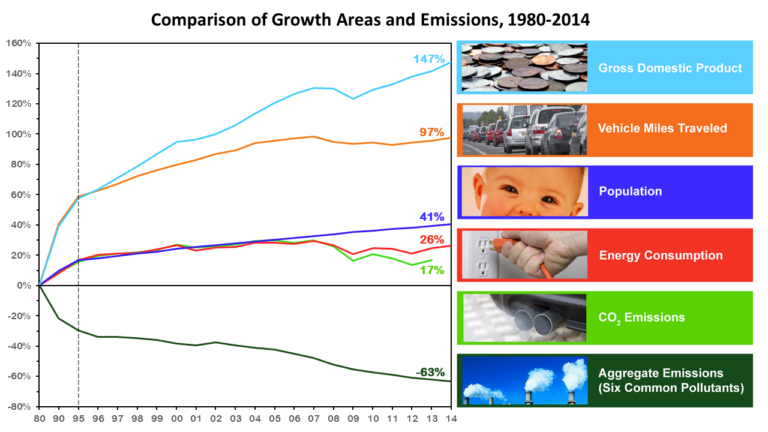Earth Day: Continuing a Storied Tradition of Misleading Claims and Outrageous Predictions

Today, millions of people around the world are celebrating Earth Day. Since its inception in 1970, Earth Day, and the environmental movement in general, has been plagued by incorrect predictions and factually wrong claims.
Earth Day’s Legacy of Inaccuracy
In their 1970 Earth Day edition, Life Magazine stated, “Scientists have solid experimental and theoretical evidence to support…the following predictions: In a decade, urban dwellers will have to wear gas masks to survive air pollution…by 1985 air pollution will have reduced the amount of sunlight reaching earth by one half….”.
The reality is that air quality was already improving in major cities around the United States and air quality continued to improve after 1970 through today.
Similarly, in the 1970 Earth Day issue of The Progressive, Harvard biologist and alarmist Paul Ehrlich laid out a doomsday scenario where between 1980 and 1989, 4 billion people, including 65 million Americans, would perish in what he termed the “Great Die-Off.” Instead, global population grew by over 800 million during the 1980s.
And let’s not forget failed presidential candidate turned millionaire environmental activist Al Gore, who in January of 2006 claimed that if we didn’t take “drastic measures” to reduce greenhouse gas emissions, that we would reach a “point of no return” in ten years. For those keeping track, this June marks the ten-year anniversary of Gore’s climate alarmist documentary “An Inconvenient Truth,” whose dire predictions look flimsier and more absurd every year.
As time has passed, we’ve seen just how absurd these predictions really were. However, the environmental movement and Earth Day activists continue to make misleading claims about the environment and particularly our use of natural gas, oil and coal. For a group that celebrates “consensus science” at every opportunity, the environmentalist movement’s predictions seem closer to science fiction than reality.
A Model for Our Kids?
On Earth Day 2015, in a conversation with mechanical engineer and children’s entertainer Bill Nye, President Obama stated, “I have the capacity to look at facts and base my conclusions on evidence… Part of shifting our political culture, I think, is we’ve got to model for our kids that facts matter.”
We agree with the president: facts matter. That’s why this Earth Day, we should pay attention to the facts about energy and the environment, instead of the alarmist rhetoric of the environmental movement.
Here are some of the top myths we continue to hear from the environmental movement:
MYTH: The environment is getting worse.
If you listen to the rhetoric from the national environmental movement, you would think the quality of our air and the environment was in pretty poor shape and only getting worse. The American Lung Association, one of the biggest advocates for overreaching EPA regulations like the so-called “Clean Power Plan,” tells us that over half of Americans are breathing in polluted air. Groups like the Sierra Club say we have to move beyond resources like natural gas, oil, and coal because they pollute our air.
But the data tell us that air quality in the United States is actually improving. According to the following chart from the EPA, emissions from the six criteria pollutants declined by 70 percent since the 1970’s even as we’ve consumed more energy, increased our population, and driven more miles in our vehicles:
But it’s not just air quality that has improved. America’s water is also cleaner. As Strata Policy points out:
“Water quality today is far better than it was a century ago…In 1900, 35 Americans per 100,000 died of typhoid and paratyphoid, 8 per 100,000 died of malaria, and 12 per 100,000 died of dysentery. By 1970, four years before the passage of the Safe Drinking Water Act, all those death rates had fallen virtually to zero.”
The 2007 Cato Institute publication The Improving State of the World, written by Indur Goklany, chronicled the myriad ways in which human beings are thriving today beyond what was even imaginable for previous generations. As the press release states, “Goklany confronts foes of globalization and demonstrates that economic growth, technological change and free trade helped power a ‘cycle of progress’ that in the last two centuries enabled unprecedented improvements in every objective measurement of human well-being.”
For the environmentalist movement, the obvious progress of modern civilization–including cleaner and safer air and water than ever before–falls on deaf ears.
MYTH: CO2 is dirty and bad for your health.
Faced with the reality that the air is actually getting cleaner, the environmental movement has shifted their focus to what they call “carbon pollution.” In reality, what they’re referring to is the emission of carbon dioxide or the emissions of greenhouse gases.
Al Gore has referred to carbon dioxide as sewage. In an interview with Ezra Klein, Gore said, “[I]n spite of the continued released [sic] of 90 million tons of global warming pollution every day into the atmosphere, as if it’s an open sewer, we are now seeing the approach of a global political tipping point.”
Environmental groups like the Sierra Club claim that carbon dioxide is “linked to life-threatening air pollution—such as the smog that can trigger asthma attacks,” and that establishing regulations for carbon dioxide will “ensure that our kids, our communities and America’s workforce are healthier…”
But when asked by FactCheck.org back in 2011 about connections between carbon dioxide and asthma, Dr. David Bernstein, professor of medicine at the University of Cincinnati stated:
“To my knowledge, there is no convincing evidence in the medical literature indicating that CO2 and methane directly affect asthma symptoms, asthma morbidity or asthma mortality. This would be considered misinformation. We’re more concerned about ozone, particulate matter, nitrogen dioxide and sulphur dioxide.”
Carbon dioxide is not dirty, and is not poisonous to humans in concentrations we observe in the atmosphere. In fact, carbon dioxide is the natural product of combustion–whether that combustion occurs within our cells (which is why humans exhale carbon dioxide), or whether carbon dioxide results from the combustion of natural gas. Carbon dioxide is essential to life on Earth because vegetation requires carbon dioxide to survive and thrive.
However, the point about asthma and respiratory illnesses remains. It’s true that cases of asthma have increased in recent years, but with emissions of the six criteria pollutants decreasing and CO2 not linked to respiratory problems, what’s to blame?
A study from Johns Hopkins University found that asthma was more closely linked to poverty; and specifically, indoor air pollution linked to poverty. The policies that environmental activists advocate for, such as shutting down our nation’s affordable and reliable coal power plants, will make energy more expensive. And as we have seen in countries that have made electricity a luxury good through ill-advised energy policy–like Germany–higher energy costs exacerbate poverty and the negative health impacts associated with it.
MYTH: We must use less natural gas, oil, and coal.
Environmental campaigners tells us that we must move away from the use of natural gas, oil, and coal to avoid environmental disaster and climate change. This sentiment–that we need to “break up” with fossil fuels–is embodied in the keep it in the ground campaign, which is an effort to stop all production of natural gas, oil, and coal. As Greenpeace claims on its website, “To avoid the worst impacts of climate change, we need to keep the world’s remaining fossil fuels in the ground. That means moving away from coal, oil, and natural gas, and towards a renewable energy future.”
First of all, it’s important to note that even if we were to completely eliminate carbon dioxide emissions here in the U.S., such a dramatic move would only reduce average global temperatures by 0.17 degrees Celsius by 2100.
Second of all, using affordable, reliable energy improves our lives. Some of the most affordable and reliable energy is natural gas, oil, and coal. These three sources make up over 80 percent of the energy Americans use because they are abundant, affordable, and reliable. They’re the sources that keep our lights on – no matter the weather – and our vehicles moving forward.
Not only are these important energy sources, but natural gas, oil, and coal are essential building blocks to many of the products that we use every day. For example, oil is used to create everything from plastics used in life-saving equipment at hospitals to the Kevlar that keeps our police officers and military personnel safe. Simply put, the use of natural gas, oil, and coal makes modern life possible.
MYTH: We can and should transition to 100 percent renewables (and it’s easy).
Environmental campaigners claims that we can transition to 100 percent renewable energy by using politically correct technologies such as wind and solar. In fact, it’s in vogue right now for companies like Apple, Google, and Procter & Gamble to claim they’re transitioning toward powering their operations with 100 percent renewable energy. These claims range from completely misleading to downright lying, as IER explains:
“…members of the “100 percent renewable” club are, in reality, not powered exclusively by renewables. Rather, they are connected to the power grid, which is nowhere near 100 percent renewable. In fact, it’s 86 percent powered by coal, natural gas, and nuclear power. And there’s good reason for that—these technologies offer low-cost, reliable power when and where it is needed. By contrast, wind and solar power combined to produce between only 5 and 6 percent of the electricity in the U.S., and their supply is intermittent and often too far away from population centers to be economic.”
So how do these companies claim to be powered by 100 percent renewables? By purchasing Renewable Energy Credits (RECs). As IER goes on to explain:
“RECs amount to a piece of paper saying the company has ‘offset’ some of the electricity the company buys from conventional sources on the grid—the credits themselves can be bought and sold independent of the renewable energy itself.”
In reality, these companies are playing a paper-trading game for PR purposes. Moving toward 100 percent renewable energy is neither feasible nor desirable. Wind and solar power are expensive and unreliable sources of electricity. In fact, electricity from new wind resources is about three times as expensive as electricity from existing coal and nuclear sources.
Additionally, wind and solar are unreliable sources of energy, which means cost comparisons between reliable sources and wind or solar power are intrinsically misleading. They only operate when the sun is shining or the wind is blowing. You can’t reliably run a power grid when the sources are intermittent, which–combined with the overwhelming cost effectiveness of reliable sources over wind and solar power–is why we get most of our electricity from sources like natural gas, nuclear, and coal.
Conclusion
Over the years, Earth Day and the broader environmental movement have produced many outlandish predictions that have been proven false. And while some of the arguments have changed in recent years, the strategy of spreading false and misleading information has not. Today, the environmental movement warns us of the impending disaster that awaits us if we do not stop using energy from natural gas, oil, and coal. However, the evidence simply does not support their claims. In fact, using abundant, reliable energy resources greatly improves life on Earth.

